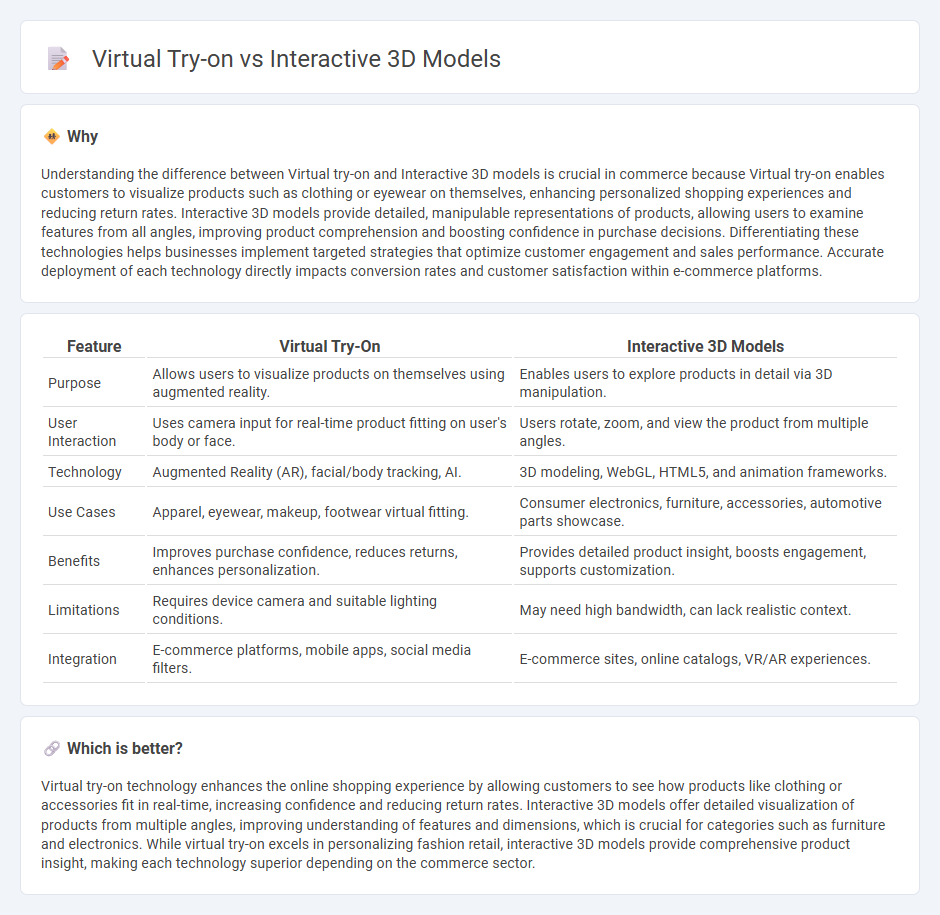
Virtual try-on technology enables consumers to visualize products such as clothing and accessories on themselves using augmented reality, enhancing online shopping confidence. Interactive 3D models allow users to explore products from multiple angles and customize features, offering a detailed and engaging experience that bridges the gap between physical and digital retail. Discover how these innovative tools are transforming commerce by increasing customer satisfaction and reducing return rates.
Why it is important
Understanding the difference between Virtual try-on and Interactive 3D models is crucial in commerce because Virtual try-on enables customers to visualize products such as clothing or eyewear on themselves, enhancing personalized shopping experiences and reducing return rates. Interactive 3D models provide detailed, manipulable representations of products, allowing users to examine features from all angles, improving product comprehension and boosting confidence in purchase decisions. Differentiating these technologies helps businesses implement targeted strategies that optimize customer engagement and sales performance. Accurate deployment of each technology directly impacts conversion rates and customer satisfaction within e-commerce platforms.
Comparison Table
| Feature | Virtual Try-On | Interactive 3D Models |
|---|---|---|
| Purpose | Allows users to visualize products on themselves using augmented reality. | Enables users to explore products in detail via 3D manipulation. |
| User Interaction | Uses camera input for real-time product fitting on user's body or face. | Users rotate, zoom, and view the product from multiple angles. |
| Technology | Augmented Reality (AR), facial/body tracking, AI. | 3D modeling, WebGL, HTML5, and animation frameworks. |
| Use Cases | Apparel, eyewear, makeup, footwear virtual fitting. | Consumer electronics, furniture, accessories, automotive parts showcase. |
| Benefits | Improves purchase confidence, reduces returns, enhances personalization. | Provides detailed product insight, boosts engagement, supports customization. |
| Limitations | Requires device camera and suitable lighting conditions. | May need high bandwidth, can lack realistic context. |
| Integration | E-commerce platforms, mobile apps, social media filters. | E-commerce sites, online catalogs, VR/AR experiences. |
Which is better?
Virtual try-on technology enhances the online shopping experience by allowing customers to see how products like clothing or accessories fit in real-time, increasing confidence and reducing return rates. Interactive 3D models offer detailed visualization of products from multiple angles, improving understanding of features and dimensions, which is crucial for categories such as furniture and electronics. While virtual try-on excels in personalizing fashion retail, interactive 3D models provide comprehensive product insight, making each technology superior depending on the commerce sector.
Connection
Virtual try-on technology enhances e-commerce by allowing customers to visualize products like clothing, accessories, or eyewear in real-time using augmented reality. Interactive 3D models provide detailed, manipulable representations of products, enabling shoppers to examine features and fit from multiple angles before purchase. Together, these innovations improve user engagement, reduce return rates, and boost online conversion rates in digital commerce.
Key Terms
Augmented Reality (AR)
Augmented Reality (AR) enhances the retail experience by integrating interactive 3D models that allow users to visualize products with detailed spatial manipulation, offering a comprehensive understanding of size, shape, and texture. Virtual try-on leverages AR to enable customers to virtually wear or use products such as clothing, accessories, or makeup, increasing engagement and reducing return rates by simulating real-world appearance. Explore how AR-powered interactive 3D models and virtual try-on technologies are transforming customer interaction and boosting e-commerce conversion rates.
Product Visualization
Interactive 3D models enhance product visualization by allowing users to rotate, zoom, and inspect items from every angle, improving engagement and purchase confidence. Virtual try-on technology superimposes products like clothing or accessories onto users in real-time, offering a personalized shopping experience that reduces returns. Explore how these innovative tools transform e-commerce by visiting our detailed insights.
User Engagement
Interactive 3D models boost user engagement by allowing customers to manipulate products, view details from multiple angles, and customize features in real-time. Virtual try-on technology enhances personalization by enabling users to visualize products, such as apparel or eyewear, directly on themselves, increasing confidence and reducing return rates. Discover how these immersive tools transform shopping experiences and drive higher conversion rates.
Source and External Links
Sketchfab - The largest platform for publishing, sharing, and discovering interactive 3D models on the web, mobile, AR, and VR with embeddable players and powerful editing tools.
Spline - A free online 3D design tool with real-time collaboration, easy modeling, animation, and web embedding focused on creating interactive 3D web experiences.
<model-viewer> - An open-source web component to easily display interactive 3D models and AR experiences on modern browsers with simple integration and broad browser support.
 dowidth.com
dowidth.com